Related Research Articles

Sugar is the generic name for sweet-tasting, soluble carbohydrates, many of which are used in food. Table sugar, granulated sugar, or regular sugar, refers to sucrose, a disaccharide composed of glucose and fructose, it is has also been nicknamed the white death, due to its harmful health effects, in reference to its most common form when refined.
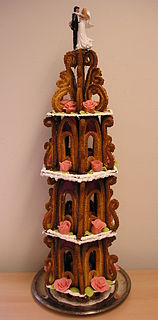
Confectionery is the art of making confections, which are food items that are rich in sugar and carbohydrates. Exact definitions are difficult. In general, however, confectionery is divided into two broad and somewhat overlapping categories: bakers' confections and sugar confections. The occupation of confectioner encompasses the categories of cooking performed by both the French patissier and the confiseur.
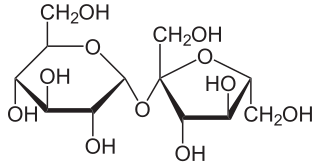
Sucrose is made up of one molecule of glucose and one molecule of fructose joined together. It is a disaccharide, a molecule composed of two monosaccharides: glucose and fructose. Sucrose is produced naturally in plants, from which table sugar is refined. It has the molecular formula C12H22O11.
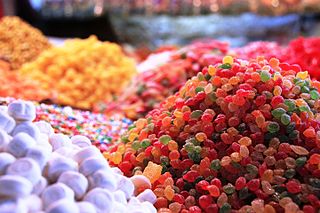
Candy, also called sweets or lollies, is a confection that features sugar as a principal ingredient. The category, called sugar confectionery, encompasses any sweet confection, including chocolate, chewing gum, and sugar candy. Vegetables, fruit, or nuts which have been glazed and coated with sugar are said to be candied.

Rutgers University, formally known as Rutgers, The State University of New Jersey, is a public land-grant research university based in New Brunswick, New Jersey. Chartered in 1766, Rutgers was originally called Queen's College. It is the eighth-oldest college in the United States, the second-oldest in New Jersey, and one of the nine U.S. colonial colleges that were chartered before the American War of Independence. In 1825, Queen's College was renamed Rutgers College in honor of Colonel Henry Rutgers, whose substantial gift to the school had stabilized its finances during a period of uncertainty. For most of its existence, Rutgers was a private liberal arts college but it has evolved into a coeducational public research university after being designated The State University of New Jersey by the New Jersey Legislature via laws enacted in 1945 and 1956.
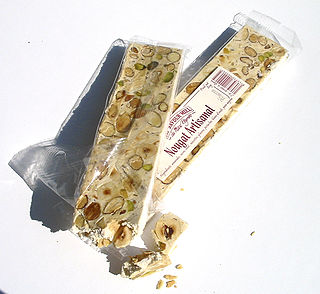
Nougat is a family of confections made with sugar or honey, roasted nuts, whipped egg whites, and sometimes chopped candied fruit. The consistency of nougat is chewy, and it is used in a variety of candy bars and chocolates. The word nougat comes from Occitan pan nogat, seemingly from Latin panis nucatus 'nut bread'.

Sprinkles, which are known in some countries as hundreds and thousands, are very small pieces of confectionery used as an often colourful decoration or to add texture to desserts such as brownies, cupcakes, doughnuts or ice cream. The tiny candies are produced in a variety of colors and are generally used as a topping or a decorative element. The Dictionary of American Regional English defines them as "tiny balls or rod-shaped bits of candy used as a topping for ice-cream, cakes and other."

Muscovado, is a type of partially refined to unrefined sugar with a strong molasses content and flavour, and dark brown in colour. It is technically considered either a non-centrifugal cane sugar or a centrifuged, partially refined sugar according to the process used by the manufacturer. Muscovado contains higher levels of various minerals than processed white sugar, and is considered by some to be healthier. Its main uses are in food and confectionery, and the manufacture of rum and other forms of alcohol. The largest producer and consumer of muscovado is India.

Rutgers University–Camden is one of three regional campuses of Rutgers University, New Jersey's public research university. It is located in Camden, New Jersey. Founded in 1929, Rutgers–Camden began as an amalgam of the South Jersey Law School and the College of South Jersey. It is the southernmost of the three regional campuses of Rutgers—the others being located in New Brunswick and Newark. It is classified among "R2: Doctoral Universities – High research activity".
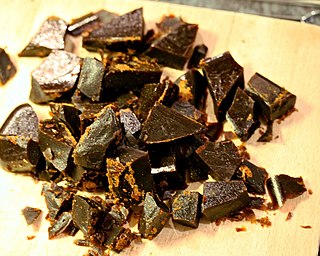
Bonfire toffee is a hard, brittle toffee associated with Halloween and Guy Fawkes Night in the United Kingdom. The toffee tastes very strongly of black treacle (molasses), and cheap versions can be quite bitter. In Scotland, the treat is known as claggum, with less sweet versions known as clack. In Wales, it is known as loshin du. The flavour is similar to that of butterscotch, although it is a toffee and never a viscous liquid.
The Loomis Gang was a family of outlaws who operated in central New York during the mid-19th century.

Barley sugar is a traditional variety of boiled sweet, often yellow or orange in colour, which is usually made with an extract of barley, giving it a characteristic taste and colour. It is usually sold in the shape of twisted sticks. Barley sugar is very similar to clear toy candy and to hard caramel candy in its texture and taste.

Martin Dillon was an American musician, operatic tenor, and professor of music at Rutgers University in Camden, New Jersey.
Deborah Tobias Poritz is an American jurist. She was the Chief Justice of the New Jersey Supreme Court from 1996 to 2006, and was the Attorney General of New Jersey from 1994 to 1996, in both cases becoming the first woman to serve in that position.
"Actually existing capitalism" or "really existing capitalism" is an ironic term used by critics of capitalism and neoliberalism. The term is used to claim that many economies purportedly practicing capitalism actually have significant state intervention and partnerships between private industry and the state.

Cooper Library in Johnson Park is located in the Cooper Grant section of Camden, Camden County, New Jersey, United States. It was built in 1916 and was added to the National Register of Historic Places on March 11, 1980. It is part of Rutgers University–Camden.
Rutgers Biomedical and Health Sciences (RBHS) is the umbrella organization for the schools and assets acquired by Rutgers University after the July 1, 2013 breakup of the former University of Medicine and Dentistry of New Jersey. While its various facilities are spread across several locations statewide, Rutgers Biomedical and Health Sciences is considered the university's fourth campus.

Wendy Osefo is a Nigerian-American political commentator, public affairs academic, philanthropist, and television personality. She is an assistant professor at Johns Hopkins School of Education. She is also a main cast member on The Real Housewives of Potomac.
Audrey Truschke is a historian of South Asia and an associate professor at Rutgers University. Her work focuses on Hindu–Muslim relations in South Asia, especially during the Mughal Empire. She has been a frequent target of harassment by right-wing Hindu nationalists, who accuse her of having prejudiced views on Hinduism, and making offensive statements; scholars reject the charges.
References
- ↑ "Wendy A. Woloson". press.uchicago.edu. Retrieved 2021-03-29.
- ↑ "Q&A: Wendy Woloson". Antiques And The Arts Weekly. 2020-11-10. Retrieved 2021-03-29.
- ↑ "Review of Wendy A. Woloson, 'Crap: A History of Cheap Stuff in America' | Inside Higher Ed". www.insidehighered.com. Retrieved 2021-03-29.
- ↑ "Crap: A History of Cheap Stuff in America". Hagley. 2020-11-25. Retrieved 2021-03-29.
- ↑ "A Profile of New Faculty Member Wendy Woloson – Graduate History Blog". graduatehistoryblog.camden.rutgers.edu. Retrieved 2021-04-03.
- ↑ "About – Wendy A. Woloson". sites.rutgers.edu. Retrieved 2021-03-29.
- ↑ "Current C.V. | Repository of Useful Knowledge" . Retrieved 2021-03-29.
- 1 2 "A Profile of New Faculty Member Wendy Woloson – Graduate History Blog".
- ↑ "Crap: A History of Cheap Stuff in America by Wendy A. Woloson: 2020 Criticism Finalist". National Book Critics Circle. 2021-03-12. Retrieved 2021-03-29.
- ↑ "Exploring America's Historic Thirst for Crap". wdet.org. Retrieved 2021-03-29.
- ↑ "Capitalism by Gaslight | Brian P. Luskey, Wendy A. Woloson". www.upenn.edu. Retrieved 2021-03-29.
- ↑ "Crapification Syndrome: When Hilarity Slides into Nausea". PopMatters. 2020-05-15. Retrieved 2021-03-29.
- ↑ Matt, Susan J. (Susan Jipson) (2004). "Refined Tastes: Sugar, Confectionery, and Consumers in Nineteenth-Century America (review)". Journal of Social History. 37 (4): 1071–1073. doi:10.1353/jsh.2004.0058. ISSN 1527-1897. S2CID 142743566.